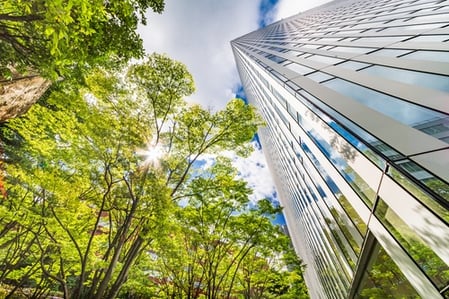Zero energy buildings (ZEB) are efficient constructions that produce enough renewable energy on site to meet their annual consumption and associated losses. ZEBs reduce non-renewable energy consumption in the construction sector.
Buildings have many energy needs , which include space heating, cooling, ventilation, hot water, lighting, plug loads, process energy, and transportation. The first step to achieving ZEBs is increasing energy efficiency, and there are several viable methods:
-
Construction of green buildings using passive design
-
Efficient building systems and appliances
-
Improve energy efficiency with maintenance and changes in user behavior.
When a building becomes as efficient as possible, the second step is to meet remaining energy needs with on-site renewable production and excess production is transferred to the grid. Some examples are wind, solar and water energy.
Improve your building's energy performance.
How to achieve zero energy buildings
Zero energy is an achievable goal and more and more developers are interested in zero energy buildings. To make a ZEB easier to understand, the U.S. Department of Energy (DOE) and the National Institute of Building Sciences have developed a common definition that can be applied to individual buildings, campuses, portfolios, and communities.
The “A Common Definition for Zero Energy Buildings” report was created to establish key definitions, nomenclature and measurement guidelines for governments, institutions and building owners. To be considered a ZEB, a building must meet two important conditions:
-
The building must be energy efficient .
-
The energy produced on site is greater than or equal to the energy consumed at the source.
-
In other words, local energy production must be high enough to meet the needs of the building, while at the same time having enough surplus production to equal or exceed the energy use of the source.
To better understand the definition of a ZEB, the first step is to define the site boundary: the line that marks the limits of the building, through which energy delivered and energy exported are measured.
-
Delivered energy is any type of energy that can be purchased for use in the building. This includes grid electricity, district heating and cooling, and fuels (renewable and non-renewable).
-
The exported energy is local renewable generation that is used outside the site boundaries. This usually occurs via the electrical grid, but renewable energy can also be used to charge electric cars used abroad.
Basically, a ZEB balances its energy consumption so that the energy exported is equal to or greater than the energy delivered annually. The building can be a net consumer of electricity for a few months, as long as it reaches zero net production or net consumption annually.

The importance of the energy source
The US Environmental Protection Agency emphasizes the importance of energy source in analyzing a building's performance, as it reflects the true impact of the property.
Consider that the energy that reaches a building doesn't get there by itself – a lot of energy is also used for production and delivery. For example:
-
Electricity delivery causes losses on the electrical grid
-
Natural gas supply requires compression stations
-
Many fuels are delivered by truck.
You can have a building that produces enough energy to match local consumption, but it's not really a ZEB. Although production and consumption are equivalent locally, energy consumption from the source is greater than; the building is a net consumer, even when it looks like a ZEB based on local consumption and generation.
How Renewable Energy Certificates Incentivize ZEBs
Renewable Energy Certificates (REC) are an effective incentive for clean energy generation. Authorities set renewable energy targets that are binding on key players in the energy sector, such as utility companies and large consumers. These organizations must deliver a specific number of RECs at regular intervals, or face heavy penalties. In turn, RECs are credited based on renewable energy generation.
-
When a REC program is introduced, energy consumers who are not subject to renewable energy targets can also achieve them. Although the exact tariff can change, the most common practice is to grant a REC for every 1,000 kWh of generation.
-
Companies subject to clean energy targets typically use their own RECs, but may also purchase them from third parties.
-
Buildings with renewable energy systems now obtain two financial benefits: savings from producing their own energy and income from REC sales.
REC programs provide an incentive for building owners to produce more renewable energy. Therefore, more properties can become ZEBs. The transition to zero-energy buildings provides many long-term benefits: lower environmental impacts, reduced operation and maintenance costs, greater resilience against blackouts and natural disasters, and greater energy security.

